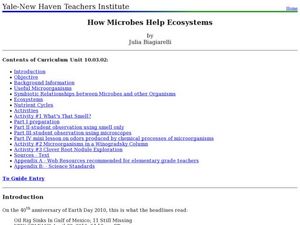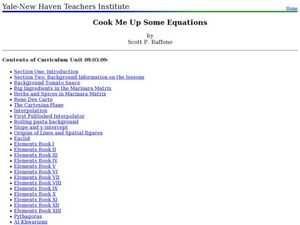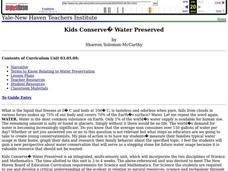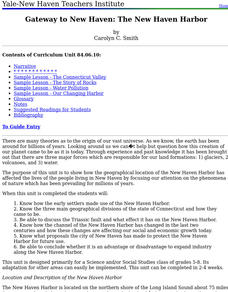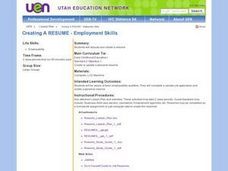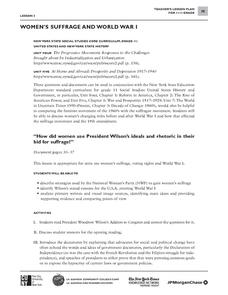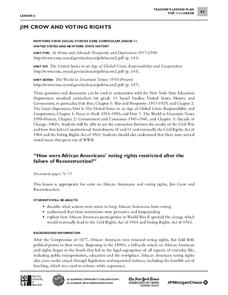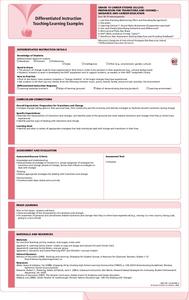Curated OER
Four Immigrant Groups: Their Lives and Music
Fourth graders examine the experiences of four immigrant groups. Class members brainstorm a list of misconceptions of those groups and discuss if these perceptions are still present today. Using maps, groups locate the countries of...
Curated OER
How Microbes Help Ecosystems
Sixth graders observe different microorganisms under the microscope. In this biology lesson, 6th graders draw and describe the samples they see. They study the root nodules of plants and explain how the plants benefit from those bacteria.
Curated OER
Using Mathematics to Explain the Spread of Diseases
Students use statistics to solve problems based on the spread of disease. In this disease lesson students study the role that viruses and bacteria play in the spread of diseases and explain pandemics.
Curated OER
Connecticut Wildlife: Biodiversity and Conservation Status of Our Vertebrate Populations
Students explore the different types of vertebrates found in their area. In this environmental science lesson, students perform a case study on the Common Raven. They analyze data collected from research and create charts and graphs.
Curated OER
Cook Me Up Some Equations
Students study a variety of math concepts in the context of cooking up a meal. In this math activity, students calculate surface area and volume. They draw and interpret different types of graphs.
Curated OER
Who am I and Why?
Learners make comparisons about themselves and others, which are real and meaningful. They study some basic concepts in the area of genetics and do a complimentary series of experiments, or explorations that illustrate these concepts
Curated OER
Crystals in the World around Us
Students grow a number of crystals, ask questions and experiment. They have a display showing their crystals in various stages of development. Additionally, they have models of crystals to take home. They study the forces that shape...
Curated OER
The Challenge to Deliver Insulin
Students study the types of diabetes and why insulin is important. In this diabetes instructional activity students build molecular models and create a healthy lifestyle plan.
Curated OER
Kids Conserve? Water Preserved
Middle schoolers study conservation and how cities obtain their water. In this water lesson students view a PowerPoint presentation and draw a picture of the water cycle.
Curated OER
Gateway to New Haven: The New Haven Harbor
Students study how the geographical location of the New Haven Harbor has affected the lives of the people living in New Haven by focusing our attention on the phenomena of nature which has been prevailing for millions of years in this...
Curated OER
Social Studies: Dealing with Grief
Students discover how to deal with grief by accepting their feelings. During a musical/meditative session they recall a time when they lost someone or something they loved and progress to a feeling of happiness for having had known...
Curated OER
Creating A RESUME - Employment Skills
Students discuss and create a resume. They are aware of basic employability qualities. Students complete a sample job application and create a personal resume. They listen to a speaker, lecture to them about how to apply for jobs.
Curated OER
The Impacts of Human Activities on Biodiversity in New Haven County
Students discover how plants and animal ecosystems are affected by the growth of a city. In this ecology lesson, students study and observe a plant over a period of time. They develop a creative presentation of their data and share them...
Curated OER
A Proposal to Lessen World Hunger
Fifth graders conduct research. They explore how to give an oral presentation with visual aids. Students have the opportunity to create a proposal which could help alleviate world hunger. They brainstorm different ways children could...
City University of New York
The Split Over Suffrage
Compare and contrast Frederick Douglass's and the National Women's Suffrage Association's stances on equal rights and suffrage with a series of documents and worksheets. Learners work together or independently to complete the packet, and...
City University of New York
Electoral College
A presidential election is a lot like the 2004 World Series, and it's also a lot like choosing an orange in a paper bag. Apply the process of the electoral college to these two analogies with a set of lessons about government...
City University of New York
Woman's Suffrage and World War I
How did women use President Wilson's ideals and rhetoric in their bid for suffrage? To answer this essential question, class groups analyze primary written documents and visual images.
City University of New York
Jim Crow and Voting Rights
Class groups examine primary source documents to determine how the voting rights of African Americans were restricted after the failure of Reconstruction, and how African American participation in World War II lead to change.
Cherry Creek Schools
Physical Science Final Exam Review Packet
If you need a way to assess the concepts in your physical science class, use an extended set of worksheets as a midterm or final exam. It includes questions about density, physical and chemical matter, speed and velocity, weight and...
Library of Congress
The Emancipation Proclamation and the Thirteenth Amendment
How did the Emancipation Proclamation lead to the Thirteenth Amendment? Middle schoolers analyze primary source documents including the text of the Emancipation Proclamation, political cartoons, photographs, and prints to understand...
EngageNY
Summarizing Complex Ideas: Comparing the Original UDHR and the "Plain Language" Version
The eighth lesson plan in this series continues the focus on vocabulary and increasing young readers' awareness of academic language. Pairs of learners participate in a short vocabulary review activity called Interactive Words in which...
Beyond Benign
Ecological Footprint
How does your lifestyle measure up in terms of your ecological footprint? Young ecologists examine their impact on the planet using an insightful online calculator. A short quiz asks users to rank the size of their homes, their energy...
Montana State University
Everest Extremes: Biodiversity
How many animals can live in a climate as cold as Mount Everest's? Find out with a science lesson plan all about biodiversity. Activities include research, presentations, group work, coloring maps, and a simulation of a food web.
EduGAINs
Preparation for Transitions and Change— Guidance and Career Education
Every hopeful in your class has gone through some kind of life change, from parents' divorce to a death in the family to moving up into another grade. Encourage them to discuss these changes, the skills they used and acquired...



